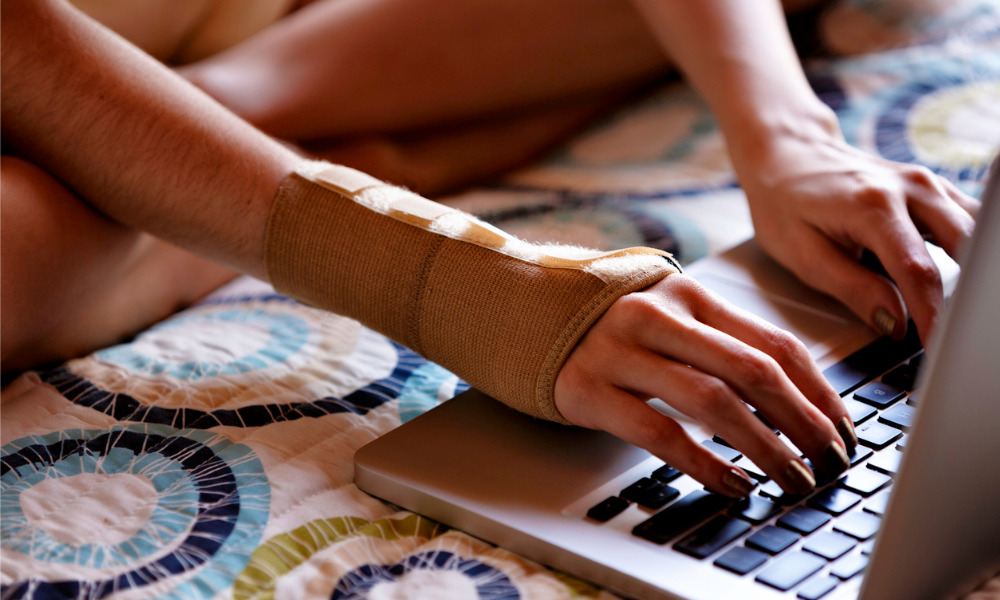Employees Who Perform Manual Tasks Continuously Are Strong Candidates for Carpal Tunnel Syndrome
Though desk jobs incur far fewer injuries than heavier industry, office workers are still at risk for a number of conditions

Though desk jobs incur far fewer injuries than heavier industry, office workers are still at risk for a number of conditions, including musculoskeletal disorders (MSDs).
In February, COS spoke with Mathew MacLeod, an occupational health and safety specialist at the Canadian Centre for Occupational Health and Safety (CCOHS) about repetitive strain injury (RSI), injuries which are more commonly referred to as MSDs.
"These injuries typically occur in the soft tissue, and so they can include muscle strains, tendon inflammation, as well as nerve impingement," says MacLeod. "These injuries can be caused or aggravated by workplace activities and demands and can manifest as mild periodic symptoms to more serious chronic and debilitating injuries."
Among the most common MSDs, carpal tunnel syndrome is a risk for many workers – especially with many Canadians still working from home. Indeed, teleworkers may lack access to ergonomic equipment which can help prevent or ease MSDs.
What is carpal tunnel syndrome?
According to various medical sources, carpal tunnel syndrome is caused by pressure on your median nerve, which is the nerve that gives you feeling in your thumb and all other fingers except for the little finger (or pinky finger).
The median nerve passes through the carpal tunnel to get to your wrist. The carpal tunnel is made up of bone and ligament.
The CCOHS says that carpal tunnel syndrome occurs when the tendons of the fingers surrounding this median nerve swell up, which reduces the space in the tunnel and squeezes the median nerve.
Symptoms of carpal tunnel syndrome include numbness, tingling pain and clumsiness of the hand.
"People with carpal tunnel syndrome experience difficulty in performing tasks such as unscrewing bottle tops, fastening buttons, or turning keys," says the CCOHS. Certain activities most commonly associated with carpal tunnel syndrome include repetitive hand motions, strong gripping, mechanical stress on the palm, awkward hand positions or vibration.
So what can people working from home do to prevent carpal tunnel syndrome? Here are eight good places to start.
Have a properly aligned work area
In an article on his website, Dr. David Wu, MD, says that when sitting at your desk, you should sit up straight and keep your elbows by your sides. He also recommends that you adjust the height of your keyboard so that your forearms are parallel to the floor. This also includes adjusting other equipment, such as your computer monitor, to make sure that it is in front on you and level with your eyes.
Take breaks when working
Provincial health line HealthLinkBC says that you should take little breaks every 10 to 15 minutes to ease strain on your wrists. It recommends setting up an alarm to help to remind to take breaks. Taking breaks is not only a great way to help prevent carpal tunnel syndrome, it also helps ease eye strain as well as other MSDs too.
Do stretching exercises
HealthLinkBC also recommends doing stretching exercises every 20 to 60 minutes.
The American Academy of Orthopaedic Surgeons has a therapeutic exercise program available on its OrthoInfo website. My Health Alberta, from the Alberta Government and Alberta Health Services (AHS), also has a number of exercises available online.
Invest in good ergonomics
Investing in good ergonomic equipment is always a good idea. Speaking with COS last year, Lisa Schuiteboer-Shuler, Kensington's certified Ergonomic Expert and Ergonomic Category Manager, said that one issue that workers face, especially those working from home, is that usually in the office the standard workstation is lower. This means that we may not be resting our wrists correctly.
"Carpal tunnel issue so prevalent," she said, by resting our wrists on the edge of the desk or table, "we put a kink or a bend in our wrist."
She recommended putting a small wrist rest at the edge of the workstation.
Try switching up: use you right hand, and then left hand
Variety is the spice of life! And it just might be the case for carpal tunnel syndrome too. Various health experts recommend switching it up between your left and right hand (if you can) to ease the pressure on each hand and wrist.
Watch your posture
This goes for all MSDs quite frankly, we all need to be a little bit more aware of our posture and make efforts to improve so as to not put unnecessary strain on various parts of our body, including our wrists and hands.
Try a different tool
There are a number of ergonomic solutions out there for those suffering with, or wishing to prevent MSDs such as carpal tunnel syndrome. HealthLinkBC recommends testing out a V-shaped keyboard, or using wrist splints to help ease any pain or discomfort.
Don't grip too tightly
Keep an eye out for how much strength you are using to perform your daily tasks, you may be using too much pressure or are tensing up without even noticing. OrthoInfo says that symptoms will occur if your hand or wrist are in the same position for too long, especially if they are flexed or extended.
Learn more about how to maintain workplace health and safety with this free resource.
Source: https://www.thesafetymag.com/ca/topics/occupational-hygiene/eight-ways-to-prevent-carpal-tunnel-when-working-at-home/256216
0 Response to "Employees Who Perform Manual Tasks Continuously Are Strong Candidates for Carpal Tunnel Syndrome"
Post a Comment